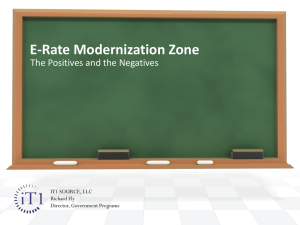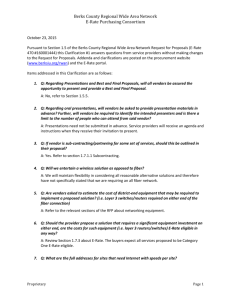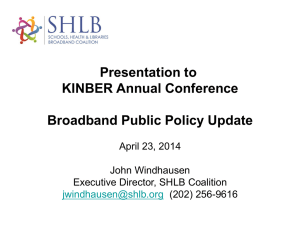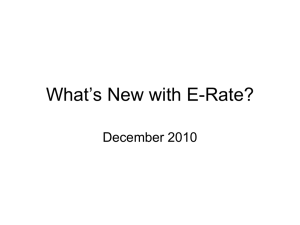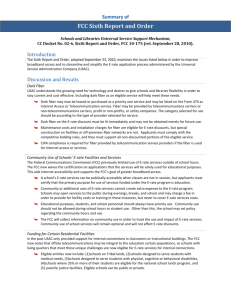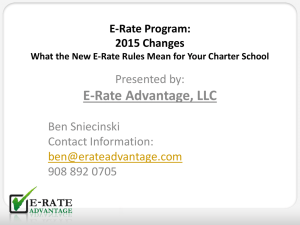E-Rate Modernization Overview for District Leaders
advertisement
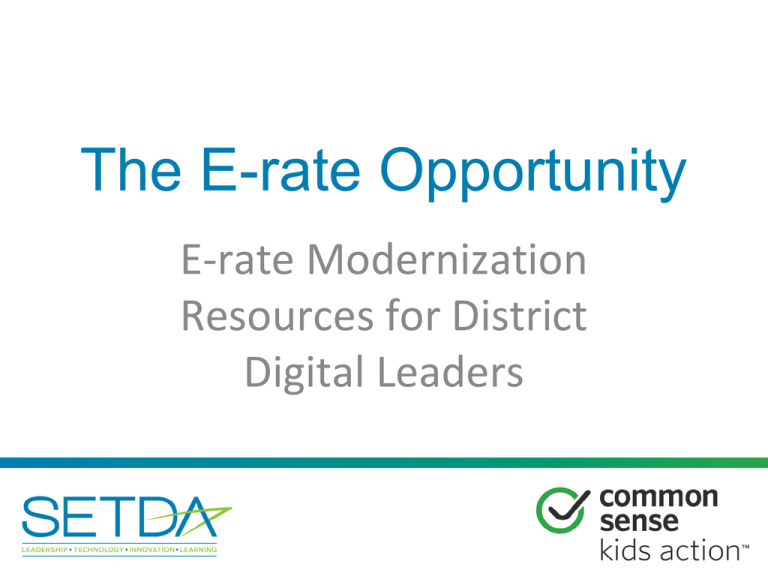
The E-rate Opportunity E-rate Modernization Resources for District Digital Leaders Overview ● Thanks to the FCC’s modernization of E-rate in 2014: ○ New: Billions of additional dollars are available to help state and local jurisdictions expand broadband and Wi-Fi connectivity in schools/libraries. ○ New: The FCC will match up to 10 percent of the state contribution for eligible new broadband construction projects for schools and libraries. ○ New: One billion dollars per year available for Wifi ○ New: Simplification of application process. ● This deck summarizes changes to E-rate and opportunities for policymakers to connect more of your schools/libraries to 21st-century learning tools. Agenda I. The Benefits of Broadband I. Understanding E-rate I. E-rate Modernization I. New State Matching Funds I. Expanded Budget for Wi-Fi I. Take Advantage of New E-rate Funds I. Resources I. The Benefits of Broadband ● 21st Century Learning o o o o Customize and personalize learning Enhance career and college ready standards Enable 1:1 ed-tech initiatives Access high-quality digital content and courses, regardless of geographic location, through distance learning ● Teacher Effectiveness o Real-time tracking of student progress o More efficient planning and prep requirements ● Libraries and schools as technology hubs o Boost access to education and jobs among local communities. II. Understanding E-rate 1. E-rate Overview 1. Relevant Agencies 1. E-rate Discounts 1. Competitive Bidding Requirements 1. Successes E-rate Overview ● Also called the Universal Service for Schools and Libraries Program. ● A federal program designed to connect schools and libraries with modern telecommunications and Internet access services. ■ Authorized by the Telecommunications Act of 1996 ■ Created by the FCC in 1997 ■ Funded through the Universal Service Fund (USF) ● Eligible schools and libraries receive ‘discounts’ on the costs of constructing and maintaining advanced telecommunications. Relevant Agencies ● Federal Communications Commission (FCC): The administrator of the Universal Service Fund (a set of telecommunication subsidies and fees used to promote universal service in the U.S.). The FCC writes the rules and standards for programs utilizing the USF. ● Universal Service Administrative Company (USAC): An independent, nonprofit corporation designated by the FCC to protect the integrity of the USF. USAC runs the E-rate program, including organizing and approving applications, conducting audits, and providing technical support to state and district E-rate coordinators. E-rate Discounts ● A discount is the percentage of the original cost of a project or service that will be paid for by E-Rate. Discounts range from 20% to 90% of project costs. ● E-rate discounts are district wide. A school or library’s discount rate is determined by the percentage of students in the district that qualify for free or reduced price lunch. ● Rural districts are eligible for an additional 5% to 10% discount compared with urban areas. E-rate Discounts E-rate Discount Calculator From the FCC’s The E-rate Program: Simplifying Discount Calculations, slide 6. Competitive Bidding Requirements ● Applicants must conduct fair and open competitive bidding process. ● Applicants must select the most cost-effective service provider. ● Price of eligible products and services must be the most heavily weighted bid evaluation factor. The Success of E-rate ● In 1996, only 14% of classrooms had access to the Internet. Most classrooms with Internet had a lowquality dial-up connection. ● By 2005, 94% of all instructional classrooms had a basic Internet connection. III. E-rate Modernization 1. Issues with E-rate 1. Modernization Orders (2014) Issues with E-rate E-rate rules and structure were largely untouched from 1996 until 2014. Despite its success, the program suffered from: ● Insufficient School/Library Connectivity. 31% of urban schools and 41% of rural schools do not have a basic fiber connection, and 68% of school districts do not have a single school that meets the FCC’s connectivity targets. ● Funding Shortages. The structure of the E-rate program prioritized broadband over Wi-Fi connections, making it nearly impossible for schools with lower discount rates to predictably access needed funds. Modernization Orders (2014) ● After extensive public input, the FCC released two modernization orders in 2014 to update E-rate. ○ Increased overall E-rate budget to $3.9 bil. ○ Set new connectivity targets: 100 Mbps Internet access per 1,000 students and staff (users) in the short term, and 1 Gbps per 1,000 users in the long term. ○ Established a dedicated state match for special construction charges, matching new state funding for special construction up to 10% per project on a dollar-to-dollar basis. ○ Made additional funds available for internal connections (WiFi). IV. New State Matching Funds 1. Act Now 1. State Matching Funds 1. Example: New York Bond Initiative 1. Example: California BIIG Grants Take Advantage of State Matching Funds Now ● Billions of dollars are available to expand broadband connectivity in local schools/libraries. ● Broadband access benefits students, teachers, parents, and communities. ● States that fund special construction projects allow schools/libraries to take advantage of FCC match. ● To qualify for the match, states must set aside new funds for eligible broadband construction projects. State Matching Funds ● 10 percent dollar-for-dollar match: The FCC will provide eligible applicants with an up to 10% additional discount for special construction charges, matching state funding for the project on a dollar-for-dollar basis. ○ For example: A district with a 40% discount can receive up to an additional 10% of E-rate funds if the state provides an additional 10% of the cost of the special construction project. ● Tribal schools and libraries: Libraries and schools operated by or receiving funding from the Bureau of Indian Education are eligible for the state match. ● Funds are available starting in the 2016 E-rate funding year. (Funding year runs July 1, 2016 through June 30, 2017.) Restrictions ● Subject to same competitive bidding requirements as other E-rate discounts. Reimbursements will only be provided to the most cost effective solutions. ● Only applies to special construction projects. Last mile buildouts, broadband infrastructure. ● Designed to encourage new state investments. States are unlikely to receive funds for general state aid. ● Eligible projects should provide infrastructure that meets or is scalable to FCC’s broadband capacity targets. 100 Mbps Internet access per 1,000 students and staff (users), short term, 1 Gbps per 1,000 users, long term. ● 15-year moratorium on match for schools/libraries that build connections using state match. But States can receive other E-rate discounts. Example: New York Bond Initiative (2014) ● Smart Schools Bond Act of 2014: Allows state to sell up to $2 bil. in bonds to finance educational technology and infrastructure in NY schools upon approval by voters. (Approved by voters in 2014.) ○ States can purchase “educational technology equipment,” including high-speed broadband infrastructure, using funds. ○ Established a “Smart Schools Review Board” to review and approve grants. ● Schools are eligible for funds based on formula school aid. Required to submit a “Smart Schools Investment Plan” to outline use of funds. Example: California Broadband Infrastructure Improvement Grant (BIIG) Program (2014) ● Aware that California students did not have broadband infrastructure to support upcoming online assessments, the CA State Legislature allocated $26.7 mil. in one-time funding for broadband infrastructure. ○ K-12 High Speed Network (K12HSN), along with the CA Board of Education, the CA Department of Education, and other public and private actors, assesses which schools have adequate access for testing. ● 277 of 300 inadequately-connected schools receive grants. Schools are only eligible if: ○ Commercial providers submit viable bids for service ○ Schools commit to paying ongoing maintenance costs ● BIIG 2.0 in the works V. Expanded Budget for Wi-Fi ● Modernization Orders set aside $1 billion per year to fulfill Category Two funding requests from FY2015-’19 ● Maximum discount of 85% ● Pre-discount budget of $150 per student for schools and $2.30 per square foot in libraries over a 5-year period ● Pre-discount funding floor of $9,200 for eligible schools. Questions? VI. Take Advantage of E-rate Funds 1. Funds are available now. 1. Start your E-rate applications early. Form 470s are now open for Funding Year 2016. Contact the FCC Wireline Competition Bureau with any questions or concerns about your network. 1. Encourage policymakers to take advantage of new state matching funds. VII. Resources 1. E-rate Resources 1. Broadband Resources 1. Definitions 1. Contact Information 1. About Us E-rate Resources 1. The E-rate Opportunity: http://www.setda.org/priorities/equity-of-access/e-ratemodernization/ 1. FCC’s E-rate Modernization Resources: https://www.fcc.gov/e-rate-update a. Modernization Order Summaries: b. First Modernization Order c. Second Modernization Order 1. USAC Resources: http://usac.org/default.aspx a. Getting Started b. Glossary of Terms Broadband Resources http://www.setda.org/priorities/equity- https://www.commonsensemedia.org/ of-access/the-broadband-imperative/ about-us/news/pressreleases/common-sense-kids-actionreleases-new-broadband-policy-brief Definitions ● Broadband: High-speed Internet access. Broadband includes several high-speed transmission technologies including: Digital Subscriber Lines (DSL); Cable Modem; Fiber; Wireless; Satellite; and Broadband Over Powerlines. ● Last Mile/Wide Area Network (WAN): School districts and library systems frequently connect individual schools and libraries at a central aggregation point, such as a district, county, or regional data hub. We refer to these connections as “last mile” or Wide Area Network (WAN) connections. ● E-rate Special Construction: The upfront cost of deploying new facilities (typically fiber), in contrast to the recurring cost of having access to facilities. ● Fiber: Fiber optic technology converts electrical signals carrying data into pulses of light and sends them through transparent glass fibers about the diameter of a human hair. A “fiber build” refers to constructing the glass fibers that will provide Internet access. ● Internet Access: School districts and some library systems purchase Internet access for the entire district or system at a single point of aggregation. “Internet access” is the connection or connections that allow traffic to flow from that aggregation point to the public Internet. Contact Information 1. [Insert State Contact] 1. FCC Contacts: a. Dana Shaffer, Deputy Managing Director (dana.shaffer@fcc.gov) b. Charles Eberle, Attorney Advisor, Wireline Competition Bureau (Charles.Eberle@fcc.gov) c. Joe Freddoso, Dark Fiber Consultant - USAC (jfreddoso@gmail.com) 1. Christine Fox, Director of Educational Leadership and Research, SETDA (cfox@setda.org) 1. Susannah Savage, Honors Policy Associate, Common Sense Kids Action (ssavage@commonsense.org) About Us SETDA and Common Sense Kids Action are working together to help finish the job of connecting all classrooms and libraries to the Internet by 2018. ● Founded in 2001, the State Educational Technology Directors Association (SETDA) is the principal nonprofit membership association representing US state and territorial educational technology leaders. Our mission is to build and increase the capacity of state and national leaders to improve education through technology policy and practice. setda.org ● Common Sense Kids Action works with policy makers, business leaders, and other advocates to ensure that every child has the opportunity to succeed in the 21st century. Our mission is to make kids and education our nation's top priority by building a membership base and driving policies that promote access for all kids to 21st-century schools, protect their online privacy, invest in early childhood supports, and reduce child poverty. https://commonsensemedia.org/kids-action
